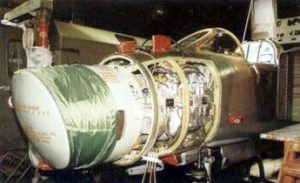Sapfir Radar

Sapfir-23 was designed by a team under Chief Designer Kunyavsky for the MiG-23 fighter. A purely air-to-air design, it was the first radar for a frontal fighter designed to allow BVR engagements. It used semiconductor technology rather than vacuum tubes and a method of external coherence in the mode “SDTs” (moving target selection) to detect aircraft flying below the host aircraft. This had limitations- it could only detect targets in the duration between successive pulses, and had multiple “blind” velocities in multiples of its PRF. It used an analogue AVM-23 computer, and a twist-cassegrain antenna. Some sources indicate that early versions could only detect closing targets. The incorporation of an IRST into the MiG-23 may therefore have been intended give a pursuit engagement capability.
Was the radar of the initial production MiG-23 (1970-71).
Was the full standard radar and the first with limited lookdown capability. Search range was 55km against a closing Tu-16 sized target, 45km against a MiG-21. Tracking range was about 35km. Fitted to production MiG-23M. Lots of problems were encountered in service, as it required expert tuning and high quality maintenance. It wasn’t uncommon for the detection range to vary 10 times from one set to the next. Weight about 500kg.
Was improved with better discrimination of low flying targets and improved ECCM. Fitted to later production MiG-23M, older MiG-23M were upgraded to this standard.
Was fitted to MiG-23MF export variants. Based on Sapfir-23D with minor differences.
Was initially designed by G. M. Kunyavsky in the early-to-mid seventies, completed by Yury Kirpichev and introduced in 1976 as a major update to the Sapfir-23, after early service experience showed various deficiencies in the original radar. As part of a crash upgrade program, the radar was thoroughly modernised, increasing ECM resistance. The Sapfir-23ML’s weight (around 350kg) was less than the original Sapfir-23, which helped improve the MiG-23’s agility. Search range against a fighter was 55km in look-up mode, 20km in look-down mode. Against a bomber sized target, the detection range increased to 80km and 25km in look-up and look-down modes repectively.
Was a variant designed for the MiG-29A, a cut-down MiG-29 intended to use existing technology to achieve IOC by 1979. Designed by Yuriy Figurovsky, it was a repackaged and slightly improved version of the MiG-23’s radar. Difficulties in fitting it into the MiG-29 were overcome by enlarging the wing roots, but it was abandoned in 1976 along with the MiG-29A. All Phazotron’s efforts were redirected to the urgent task of developing the Sapfir-25 radar.